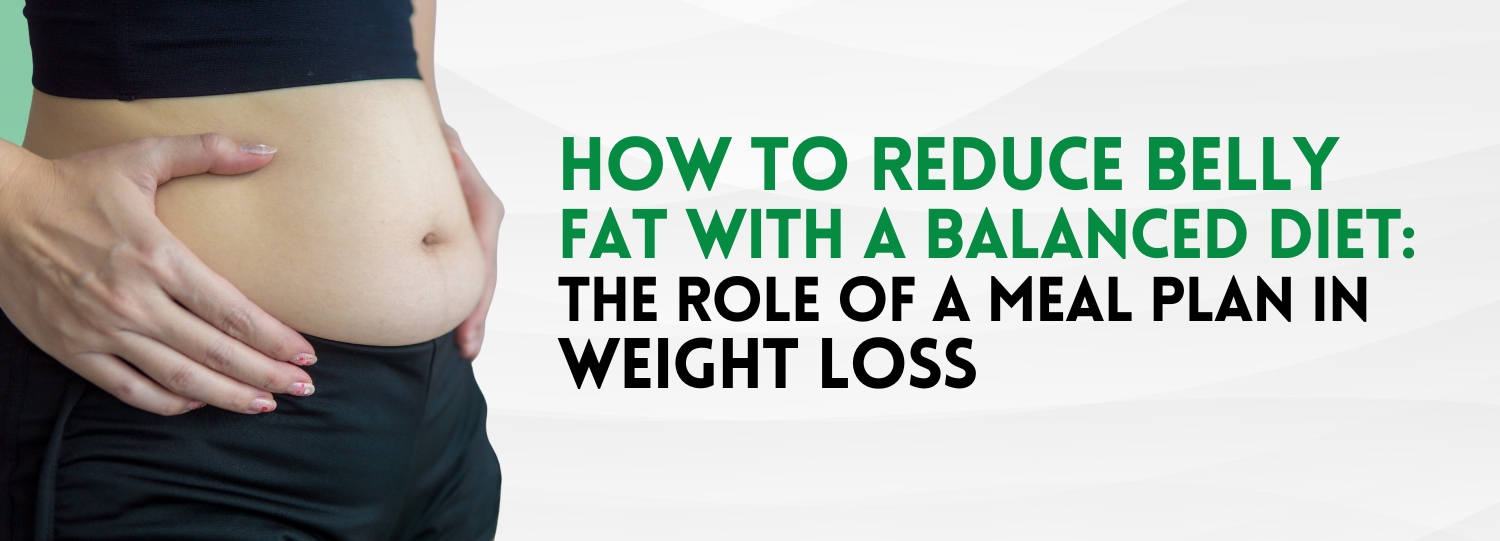
How to Reduce Belly Fat with a Balanced Diet: The Role of a Meal Plan in Weight Loss
Reducing belly fat is a common goal for many, especially those looking to improve their overall health and appearance. A balanced diet plays an important role in achieving this goal. By following a structured meal plan tailored to your needs, you can effectively target belly fat, enhance your metabolism, and promote sustainable weight loss. Whether you’re searching for a belly fat loss diet plan for males or simply want to know how to reduce belly fat with a balanced diet.
Understanding Belly Fat
Before diving into dietary strategies, it’s important to understand what belly fat is and why it’s particularly stubborn. Belly fat, or visceral fat, is stored deep within the abdominal cavity and surrounds vital organs like the liver and pancreas. It is linked to various health risks, including heart disease, diabetes, and metabolic syndrome.
The Role of a Balanced Diet
A balanced diet is essential for effective weight loss and fat reduction. It provides the necessary nutrients to support your body while helping to manage calorie intake. Here’s how a balanced diet contributes to reducing belly fat:
- Calorie Control: Consuming fewer calories than you expend creates a calorie deficit, which is necessary for weight loss. A balanced diet ensures you get enough nutrients while managing calorie intake.
- Nutrient Density: Focus on nutrient-dense foods that provide vitamins, minerals, and other essential nutrients without excess calories. These include fruits, vegetables, lean proteins, and whole grains.
- Healthy Fats: Incorporate healthy fats like avocados, nuts, and olive oil. Unlike unhealthy fats found in processed foods, these can help with satiety and reduce cravings.
- Protein Intake: Protein is essential for muscle maintenance and can boost metabolism. It also helps control hunger and keeps you feeling full longer. Include lean proteins such as chicken, fish, beans, and legumes.
- Fiber-Rich Foods: High-fiber foods, such as vegetables, fruits, and whole grains, aid digestion and can help prevent overeating by promoting a feeling of fullness.
- Limiting Refined Carbs and Sugars: Refined carbohydrates and sugars contribute to weight gain and belly fat accumulation. Opt for complex carbs like whole grains, which provide sustained energy and better blood sugar control.
7 Days Diet Plan –
Sample diet plan for belly fat reduce
Day 1
Breakfast (290 calories, 4 g fiber)
- Muffin-Tin Omelets with Feta & Peppers
- 1 medium orange
- 8 oz. green tea
A.M. Snack (214 calories, 11 g fiber)
- 1 cup low-fat kefir
- 1 cup raspberries (fresh or frozen)
- 2 tsp. chia seeds
Lunch (345 calories, 8 g fiber)
- Whole-Wheat Veggie Wrap
P.M. Snack (221 calories, 4 g fiber)
- 1/4 cup Chile-Lime Peanuts
Dinner (410 calories, 13 g fiber)
- 2 cups Baked Vegetable Soup
- 1 (4 inch) whole-wheat pita round, toasted and topped with 1/4 cup hummus
Total Intake- Calories–1,480, fibre– 41 g, Protein– 62 g, Carbohydrates– 153 g, Fat– 76 g, Sodium– 2,367 mg
The meal plan includes a good balance of protein, fiber, and carbohydrates, with a moderate amount of fat. The sodium content is on the higher side, so you might want to consider ways to reduce it if needed.
Day 2
Breakfast (290 calories, 4 g fiber)
- Muffin-Tin Omelets with Feta & Peppers
- 1 medium orange
- 8 oz. green tea
A.M. Snack (214 calories, 11 g fiber)
- 1 cup low-fat kefir
- 1 cup raspberries (fresh or frozen)
- 2 tsp. chia seeds
Lunch (324 calories, 4 g fiber)
- Spinach & Artichoke Salad with Parmesan Vinaigrette
P.M. Snack (46 calories, 2 g fiber)
- 1 1/2 cups air-popped popcorn topped with 1 tsp. Italian seasoning
Dinner (630 calories, 12 g fiber)
- 1 3/4 cups Chickpea Pasta with Lemony-Parsley Pesto
Total Intake- Calories–1, 504, Fiber– 33 protein– 62 carbohydrates– 122 g, Fat–92 g, Sodium– 1,940 mg,
Meal-Prep Tip: Save 1 cup of Sheet-Pan Roasted Root Vegetables for dinner on Day 4.
This plan offers a balanced intake of nutrients with a good variety of fiber and protein. The sodium content is within a reasonable range, but you might want to keep an eye on it if you have specific dietary restrictions.
Day 3
Breakfast (290 calories, 4 g fiber)
- Muffin-Tin Omelets with Feta & Peppers
- 1 medium orange
- 8 oz. green tea
A.M. Snack (210 calories, 4 g fiber)
- 1 medium banana
- 1 Tbsp. peanut butter
Lunch (324 calories, 4 g fiber)
- Spinach & Artichoke Salad with Parmesan Vinaigrette
P.M. Snack (159 calories, 11 g fiber)
- 1/2 cup low-fat kefir
- 1 cup raspberries (fresh or frozen)
- 2 tsp. chia seeds
Dinner (446 calories, 10 g fiber)
- Chhole (Chickpea Curry)
- 1 (6 inch) whole-wheat pita bread
Evening Snack (103 calories, 3 g fiber)
- Apple “Donuts” (2 rings)
Total Intake-Calories– 1, 526, Fibre– 35 protein– 58 carbohydrates– 163 fat– 77 sodium– 1,858 mg
This plan provides a good mix of nutrients, including a substantial amount of fiber and protein. The sodium level is within a reasonable range but is something to monitor if needed.
Day 4
Breakfast (380 calories, 10 g fiber)
- Matcha Green Tea Latte
- Everything Bagel Avocado Toast
- 2 kiwi fruit
A.M. Snack (113 calories, 1 g fiber)
- 1/2 serving (1 muffin) Muffin-Tin Omelets with Feta & Peppers
Lunch (324 calories, 4 g fiber)
- Spinach & Artichoke Salad with Parmesan Vinaigrette
P.M. Snack (222 calories, 4 g fiber)
- 1/4 cup Chile-Lime Peanuts
Dinner (453 calories, 14 g fiber)
- Roasted Root Veggies & Greens over Spiced Lentils
Daily Intake- Calories- 1,491 , Fibre- 32 g , Protein- 65 g, Carbohydrates- 130 g ,Fat- 86 g, Sodium- 1,753 mg
This plan includes a good balance of nutrients with a focus on fiber and protein. Sodium levels are manageable but should be monitored based on dietary needs.
Day 5
Breakfast (490 calories, 18 g fiber)
- 1 cup kefir
- 3/4 cup unsweetened muesli
- 3/4 cup raspberries
- 8 oz. green tea
A.M. Snack (113 calories, 1 g fiber)
- 1/2 serving (1 muffin) Muffin-Tin Omelets with Feta & Peppers
Lunch (324 calories, 4 g fiber)
- Spinach & Artichoke Salad with Parmesan Vinaigrette
P.M. Snack (95 calories, 4 g fiber)
- 1 medium apple
Dinner (497 calories, 8 g fiber)
- Spaghetti Squash & Chicken with Avocado Pesto
Daily Intake-Calories- 1,519,Fibre- 35 protein- 77 carbohydrates- 152 g, Fat- 76 g, Sodium- 1,449 mg
This plan provides a high fiber intake and a balanced mix of macronutrients. Sodium is on the lower side for the day, which is beneficial if you’re monitoring your intake.
Day 6
Breakfast (296 calories, 6 g fiber)
- Matcha Green Tea Latte
- Everything Bagel Avocado Toast
A.M. Snack (113 calories, 1 g fiber)
- 1/2 serving (1 muffin) Muffin-Tin Omelets with Feta & Peppers
Lunch (360 calories, 13 g fiber)
- White Bean & Veggie Salad
P.M. Snack (210 calories, 4 g fiber)
- 1 medium banana
- 1 Tbsp. peanut butter
Dinner (532 calories, 5 g fiber)
- Shrimp Paulista
- 1 cup cooked brown rice topped with 1 tsp. chopped parsley
- 1 cup steamed broccoli florets topped with 2 tsp. olive oil and seasoned with a pinch of salt and pepper
Total Intake- Calories– 1, 512, Fibre– 29 protein– 73 carbohydrates– 156 fat– 70 sodium– 1,666 mg
This plan offers a good amount of protein and carbohydrates, with a decent fiber intake. The sodium level is within a manageable range but should be monitored if you’re tracking your intake.
Day 7
Breakfast (290 calories, 4 g fiber)
- Muffin-Tin Omelets with Feta & Peppers
- 1 medium orange
- 8 oz. green tea
A.M. Snack (200 calories, 5 g fiber)
- 1 medium apple
- 1 Tbsp. peanut butter
Lunch (230 calories, 11 g fiber)
- White Bean & Avocado Toast
P.M. Snack (186 calories, 11 g fiber)
- 3/4 cup low-fat kefir
- 1 cup raspberries (fresh or frozen)
- 2 tsp. chia seeds
Dinner (605 calories, 8 g fiber)
- Hassel back Caprese Chicken
- 1 cup cooked brown rice
- 1/2 tsp. dried oregano
Total Intake- Calories– 1, 510, Fibre– 40, protein– 84 carbohydrates– 174, fat– 60 g, and Sodium– 1,704 mg
This plan features a high protein intake and a good amount of fiber. The sodium level is on the higher side, so consider monitoring it if needed.
Key Nutritional Insights
- Fiber: Each day incorporates a good amount of fiber, aiding digestion and helping to keep you full.
- Protein: The meals are high in protein, supporting muscle maintenance and satiety.
- Green Tea: Included daily, it may help with fat metabolism and offers additional health benefits.
- Balanced Meals: Each day provides a mix of macronutrients to keep energy levels steady and support overall health.
Tips for Following Your Diet Plan
- Stay Hydrated: Drinking plenty of water aids digestion and helps control hunger. Aim for at least 8 glasses a day.
- Meal Prep: Prepare meals in advance to avoid unhealthy food choices when you’re busy or stressed.
- Mindful Eating: Pay attention to portion sizes and avoid eating out of boredom or stress. Eat slowly and savor each bite.
- Consistency: Stick to your meal plan consistently for the best results. Consistency is key to seeing significant changes in belly fat.
Physical Activity: Complement your diet with regular exercise, including both cardio and strength training, to enhance fat loss and improve overall fitness.
Conclusion
Reducing belly fat isn’t just about aesthetics; it’s crucial for overall health and well-being. A balanced diet plays a pivotal role in this process, helping to manage calorie intake, boost metabolism, and promote fat loss while ensuring the body gets the nutrients it needs. By following a personalized meal plan, you can target stubborn belly fat effectively.
Incorporating fiber-rich foods, such as fruits, vegetables, and whole grains, helps in digestion and keeps you feeling full longer, preventing overeating. Lean proteins, like chicken, fish, and legumes, are essential for muscle maintenance and contribute to fat burning. Healthy fats, found in foods like avocado and olive oil, not only help reduce cravings but also promote satiety.
Managing your intake of refined carbohydrates and sugars is equally important, as these can lead to belly fat accumulation. Opting for whole grains and complex carbohydrates ensures stable blood sugar levels, preventing fat storage around the abdominal area.
A well-structured meal plan should also include a good balance of vitamins and minerals. Vitamins like C and K, found in tomatoes, leafy greens, and citrus fruits, help boost immunity, promote healthy skin, and support overall metabolism. Additionally, consuming meals that include antioxidant-rich foods, such as green tea, helps with fat metabolism and prevents oxidative stress.
Incorporating a balanced diet into your daily routine is a powerful strategy for reducing belly fat. By adhering to a well-structured diet plan for belly fat reduction, you can achieve noticeable results over time. Remember, consistency and discipline are key. Whether you’re focusing on a belly fat loss diet plan for males or a general approach to shedding excess weight, the right meal plan, combined with regular exercise and a healthy lifestyle, will set you on the path to success. Start today, and witness the positive changes in your body and overall well-being.
Our results are visible and measurable, and our processes are scientific, natural and safe.
Sign up for a FREE consultation with Health Total experts to get more tips for losing weight with a weight loss diet plan for men and women or managing any other health condition. Call toll-free at 1-800-833-171709 and book an appointment!
